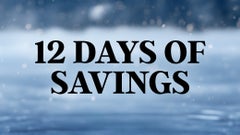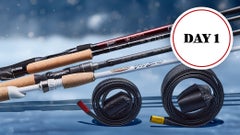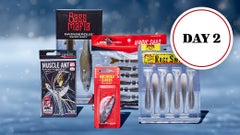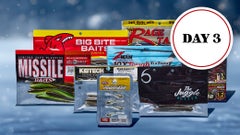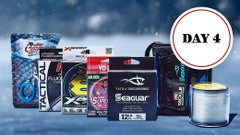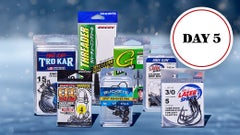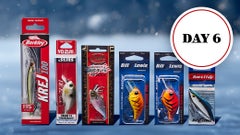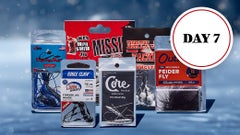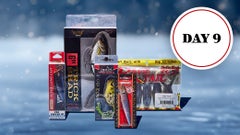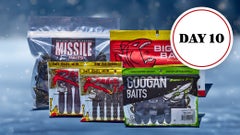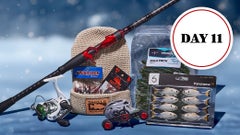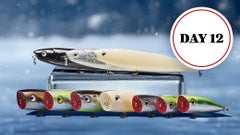Wil Hardy II Wins Oneida Lake BASS Northern Open
"The phone hasn't stopped ringing since... shoot, I don't even remember what time the weigh-in finished," said Hardy, who along with Jon Hair co-owns Georgia-based Greenfish Tackle. "What's crazy is besides a club tournament, this is the first thing I've won." Hardy's love affair with Northern fisheries can be traced to the 2008 Eastern FLW Series when the circuit visited Lake Champlain, where he competed as a co-angler. He has fished Champlain and Oneida on a handful of occasions since then, but the multi-species options that Northern lakes present has always intrigued him. "The first year I went to Champlain I fell in love with up north," he said. "My dad and I have talked about it for hours. Things just seem to come more naturally. Down here, I'll struggle, but up there I can catch something." When he comes up north, his outlook tends to change for the better. "Maybe that's it," he said. "I have a positive frame of mind. It's more like vacation than a tournament." By employing two different presentations of a Zoom Speed Craw - a Carolina rig and an Arky-style jighead - Hardy was able to keep the fish interested as he combed a flat in 11 feet of water that had a mix of hard bottom and scattered grass. "I know it's everybody's cliche, 'when it's your time, it's your time,' but you don't understand what that means until it's your time," he said. "To win a tournament of that size on one spot, it doesn't usually happen, especially sharing it with a couple of people. Everything went perfect."
Last August, Hardy finished 26th at the Oneida Northern Open using the same two presentations he used a week ago. "I figured with the month difference and with the fish coming off the spawn a few weeks ago, if I caught them that way a month later (last year), it figured to be better earlier," he said. He started practice with three rods on his deck - a dropshot, a Carolina-rigged Speed Craw and a Speed Craw rigged on a Greenfish Tackle Creeper head - he returned to the same areas that had produced for him in the past. "I caught them in the same place and everywhere I went," he said. "I started practice the Wednesday of the week before the tournament and by Friday I was ready to fish." A local tournament Saturday and the collective impact of 200 boats preparing for the Open changed the atmosphere as the tournament drew closer. "I would catch one or two everywhere I went, but you could tell it was getting tougher," he said. "In a week, I had 30 spots where I could catch one or two." But the place he ultimately sat on for 3 tournament days gave up four keepers in 15 minutes and he figured he could start there and get a limit, then hunt around for upgrades.
Competition:
Hardy had his 17-04 in the boat by 9 a.m. on day 1, allowing him to run around to many of the other areas where he found fish during practice. None of them produced - at all. "I didn't get a bite anywhere else I went," he said. "I never caught anything over 4. Everything was 3 1/2 to 3 3/4." He wasn't the only one to have found what turned out to be the winning spot. Mike Iaconelli, who finished 6th, also fished there all 3 days, but Hardy said they co-existed in a respectful manner. "There were other guys in the area, but they weren't fishing what we were fishing," Hardy said, "(Ike) never said anything or got closer than two casts. He was very courteous and gave me plenty of space." Hardy had a lower boat number on day 2 and Iaconelli won the race to the area. Hardy said he gave Ike the same respect that was given to him on day 1 and he committed to staying there for the duration. "I figured I might as well sit here all day and hammer it," Hardy said. "If I miss the cut, so be it." He worked the area hard all morning, but the bite seemed to fade off around 9 a.m. He culled just once after that, but still had 18-05 despite two dead fish. That was enough to put him in the lead entering the final day. "I have no clue why the bite would die after 9," he said. "Maybe they were there all night and gorged themselves. After that they'd pull off that bar and they'd suspend because we'd drift around and pick off one here or there, just fan casting. When they were up, they'd just cruise around on the flat." Hardy said he caught fewer fish on the final day, but they were all good quality, 3 1/2-pounders, again dragging a Carolina rig or a jighead across the flat. "The area was loaded," he said. "It was probably one of the biggest schools I've ever seen." His 18-04 stringer was good enough to salt away a 3-pound, 4-ounce win over Jacob Wheeler.
Winning Pattern:
Hardy said the key elements to the spot he fished were the shell bed surrounded by softball-sized rocks and scattered clumps of grass. "You'd throw out and feel the shells and you could tell every time you pulled it into a good area," he said. "You'd feel the gobies or the perch. They'd be all over it and two pulls after that a 3-pounder would load up on it." He had his boat positioned over 12 or 13 feet of water and was throwing up to 11. "It wasn't a huge change," he noted. "The reason I fished that one spot and found it was it was a big, flat stretch and in the middle of it, the Navionics chip showed a little point that came out. I just started fishing it. In 10 minutes, I caught four fish. I didn't have to throw to a spot. The whole point was holding them." His retrieve was pretty quick, but he made sure to maintain contact with bottom. He kept his rod tip parallel to the water or pointed down, mostly to keep any line slack out of the wind. He opted for a Carolina rig as opposed to a finesse presentation because he was able to be more efficient. "That comes from throwing it on Champlain," he added. "It's really easy and fast and I can cover a lot of water with it. A dropshot is great, but I feel like I can make four or five more casts to a place and cover more water with this compared to a dropshot."
Winning Gear:
Carolina rig gear: 7'3" medium-heavy Powell Max 3D casting rod, Shimano Chronarch Ci4+ casting reel (6.4:1 ratio), 15-pound Hi Seas fluorocarbon line, 1/2-oz. unnamed tungsten weight, unnamed swivel, 3/0 Gamakatsu EWG worm hook, Zoom Speed Craw (green-pumpkin). Hardy used an 18-inch length of 12-pound fluorocarbon from the swivel to his hook.
Creeper head gear: Same rod, same reel, same line, 3/4-oz. Greenfish Tackle Creeper head, same bait. The Creeper head is an Arky-style jig head with a corkscrew bait keeper in the head. Hardy stuck with the 3/4-oz. version more because of the breezy conditions. He caught more than half of his weigh fish on the Carolina rig, but he'd mix in the Creeper head when that bite started to fade.
Main factor: "That Carolina-rigged Speed Craw was the deal. My co-anglers would start with a dropshot, then after me catching them for 20 minutes, they'd be in the bottom of the boat retying."
Performance edge: "That Hi-Seas fluorocarbon was great. I was fishing around those shell beds and that stuff held up. I boat-flipped everything."




